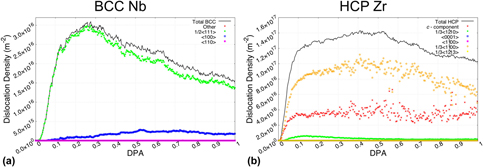Crossref Citations
This article has been cited by the following publications. This list is generated based on data provided by
Crossref.
Liu, Z.R.
Yao, B.N.
Legut, D.
Kong, X.F.
Germann, T.C.
Zhang, H.J.
and
Zhang, R.F.
2020.
Mechanistic understanding of the size effect on shock facilitated dislocation nucleation at semicoherent interfaces.
Scripta Materialia,
Vol. 178,
Issue. ,
p.
457.
Derlet, P. M.
and
Dudarev, S. L.
2020.
Microscopic structure of a heavily irradiated material.
Physical Review Materials,
Vol. 4,
Issue. 2,
Arasteh, J.
and
Akbari, G.H.
2020.
Microstructural evolution during high-energy mechanical alloying of immiscible Zr–Cr alloy.
Journal of Materials Research,
Vol. 35,
Issue. 14,
p.
1825.
Chen, Elton Y
Deo, Chaitanya
and
Dingreville, Rémi
2020.
Reduced-order atomistic cascade method for simulating radiation damage in metals.
Journal of Physics: Condensed Matter,
Vol. 32,
Issue. 4,
p.
045402.
Cusentino, M. A.
Wood, M. A.
and
Dingreville, R.
2020.
Compositional and structural origins of radiation damage mitigation in high-entropy alloys.
Journal of Applied Physics,
Vol. 128,
Issue. 12,
Vizoso, Daniel
Kosmidou, Maria
Balk, T. John
Hattar, Khalid
Deo, Chaitanya
and
Dingreville, Rémi
2021.
Size-dependent radiation damage mechanisms in nanowires and nanoporous structures.
Acta Materialia,
Vol. 215,
Issue. ,
p.
117018.
Starikov, S.
and
Smirnova, D.
2021.
Optimized interatomic potential for atomistic simulation of Zr-Nb alloy.
Computational Materials Science,
Vol. 197,
Issue. ,
p.
110581.
Laptev, Roman
Svyatkin, Leonid
Krotkevich, Dmitriy
Stepanova, Ekaterina
Pushilina, Natalia
Lomygin, Anton
Ognev, Sergei
Siemek, Krzysztof
and
Uglov, Vladimir
2021.
First-Principles Calculations and Experimental Study of H+-Irradiated Zr/Nb Nanoscale Multilayer System.
Metals,
Vol. 11,
Issue. 4,
p.
627.
Chen, Elton Y.
Hopper, Cameron P.
Santhapuram, Raghuram R.
Dingreville, Rémi
and
Nair, Arun K.
2021.
Origins of the change in mechanical strength of silicon/gold nanocomposites during irradiation.
Scientific Reports,
Vol. 11,
Issue. 1,
Novikov, N. V.
Chechenin, N. G.
and
Shirokova, A. A.
2021.
Nonadditivity effects during the passage of protons through multilayer targets.
Radiation Effects and Defects in Solids,
Vol. 176,
Issue. 11-12,
p.
1107.
Radhakrishnan, M.
Kombaiah, B.
Bachhav, M.N.
Nizolek, T.J.
Wang, Y.Q.
Knezevic, M.
Mara, N.
and
Anderoglu, O.
2021.
Layer dissolution in accumulative roll bonded bulk Zr/Nb multilayers under heavy-ion irradiation.
Journal of Nuclear Materials,
Vol. 557,
Issue. ,
p.
153315.
Dingreville, Rémi
Chen, Elton Y.
and
Deo, Chaitanya
2021.
Temperature and radiation effects on brittle versus ductile fracture behavior in miscible phase boundaries: insight from atomistic simulations.
International Journal of Fracture,
Vol. 228,
Issue. 1,
p.
1.
UGLOV, Vladimir V.
ZLOTSKI, Sergey V.
ZHORNIK, Viktor I.
VEREMEY, Ilya S.
and
SOLODUKHIN, Igor A.
2022.
RADIATION RESISTANCE OF MULTILAYER NANOSTRUCTURED COATINGS nc-ZrN/a-ZrCu IRRADIATED WITH HELIUM IONS.
Mechanics of Machines, Mechanisms and Materials,
Vol. 4,
Issue. 61,
p.
53.
Wan, Q.
Liu, Y.
Yang, B.
Zhang, J.
Xiao, Y.Y.
and
Liu, X.Q.
2022.
Enhancing irradiation tolerance via building 3D diffusion paths for He+ in multilayers by epitaxial growth.
Materials & Design,
Vol. 221,
Issue. ,
p.
111020.
Li, Rongbin
Huang, Tian
Zhang, Jing
Jiang, Chunxia
Zhang, Yong
and
Liaw, Peter
2022.
Microstructures, Mechanical Behavior, and Radiation Damage of (TiVCr)x-(TaW)1-x Binary System High-Entropy Alloy Films.
Metals,
Vol. 12,
Issue. 5,
p.
772.
Deo, Chaitanya S
Chen, Elton Y
and
Dingeville, Rémi
2022.
Atomistic modeling of radiation damage in crystalline materials.
Modelling and Simulation in Materials Science and Engineering,
Vol. 30,
Issue. 2,
p.
023001.
Barr, Christopher M.
Chen, Elton Y.
Nathaniel, James E.
Lu, Ping
Adams, David P.
Dingreville, Rémi
Boyce, Brad L.
Hattar, Khalid
and
Medlin, Douglas L.
2022.
Irradiation-induced grain boundary facet motion: In situ observations and atomic-scale mechanisms.
Science Advances,
Vol. 8,
Issue. 23,
Novikov, N. V.
Chechenin, N. G.
and
Shirokova, A. A.
2023.
Depth Distribution of Radiation Defects under Ion Irradiation of Silicon.
Поверхность. Рентгеновские, синхротронные и нейтронные исследования,
p.
50.
Tramontina, D.R.
Deluigi, O.R.
Pinzón, R.
Rojas-Nunez, J.
Valencia, F.J.
Pasianot, R.C.
Baltazar, S.E.
Gonzalez, R.I.
and
Bringa, E.M.
2023.
Probing radiation resistance in simulated metallic core–shell nanoparticles.
Computational Materials Science,
Vol. 227,
Issue. ,
p.
112304.
Manna, Mouparna
and
Pal, Snehanshu
2023.
Molecular dynamics simulation for radiation response of Nb bicrystal having Σ 13, Σ 29, and Σ 85 grain boundary.
Journal of Applied Physics,
Vol. 133,
Issue. 16,
